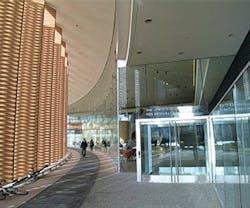Princeton Lab Reaps Payback on LED Units
On first blush, the 98,000- square-foot Carl Icahn Laboratory at Princeton University did not seem to be a cost-competitive candidate for a lighting upgrade, despite its annual lighting energy consumption of 564,000 kWh at $50,000. The labor cost of fixture removal and replacement seemed too high, and based on previous experience on campus, lab users considered simple on/off occupancy controls to be a nuisance and regularly disabled them.
Lighting in the lab and office spaces utilized 815 2-by-2-foot recessed luminaires, each with two 31-watt T8 U-lamps. The luminaires were outfitted with acrylic prismatic lens, and drew 50 watts each over an estimated 5,000 operating hours per year. At 240,425 kWh annually, the lab and office lighting accounted for 43% of the facility’s annual lighting energy.
The upgrade solution installed in the lab/office spaces consisted pan-type retrofit kits from Maxlite, a product on the DesignLights Consortium’s Qualified Products List. These units produce 3,315 lumens and draw 45 watts each. They have a minimum CRI of 82 and CCT of 4,100K.
The control/energy management solution for these spaces consisted of a Lutron Quantum Ecosystem with wireless motion and daylight sensors, wireless dimmer switches, and bi-level dimming capability in lab areas. Illuminance is varied along the lab counters from the window wall to the inside wall.
Before controls, the lab/office lighting replacement has yielded 57,000 kWh in annual energy savings.
Princeton Lab Reaps Payback
on LED Units
MGM Evaluates Its Lamp Options for
New Office Space
Think Outside the Troffer
Upgrading outdated, inefficient troffer lighting is not as complex or costly as you think
